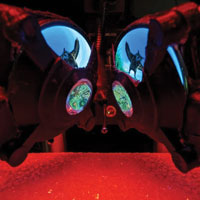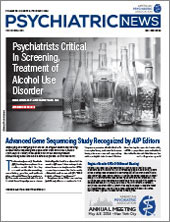Fetal Alcohol Spectrum Disorders Do Not Accelerate Brain Aging
A brain-imaging
study appearing in
JAMA Network Open has found that people with a fetal alcohol spectrum disorder (FASD) are no more likely to experience accelerated brain aging in middle age than those without FASD.
Researchers at Stanford University School of Medicine and colleagues recruited adults (average age, 42 years) who had participated in a prior FASD study two decades prior. As part of the original study, participants received a thorough clinical assessment for FASD as well as an MRI brain scan. The participants represented three groups:
•
22 adults with fetal alcohol syndrome—defined as the presence of central nervous system dysfunction, growth deficits, and sentinel facial features of prenatal alcohol exposure.
•
18 adults with fetal alcohol effects—defined as the presence of some, but not all, characteristics of fetal alcohol syndrome.
•
26 adults with no history of prenatal alcohol exposure.
The researchers performed another MRI scan and found the same pattern of brain volume differences as had been observed previously: Average total intracranial brain volume as well as the volume of specific regions such as the cerebellum were much larger in the control group than the group with fetal alcohol syndrome; the brain volumes of those with fetal alcohol effects were in between the control group and fetal alcohol syndrome group.
The researchers found no evidence of any accelerated brain aging or reversal of brain volume deficits in the two groups with prenatal alcohol exposure over the two time points.
“There is a critical need to extend the longitudinal assessment of this cohort into older ages when clearer signs of accelerated aging might manifest morphologically to track whether the FASD population is at heightened risk for premature or exacerbated dementia or other disorders of aging,” the researchers wrote.
Researchers Develop Mouse VR Goggles to Aid Brain Research
Investigators at Northwestern University and colleagues have designed a set of virtual reality (VR) goggles for mice. As detailed in Neuron, the researchers hope these goggles can recreate the animal’s natural environments and enhance the study of the brain circuits underlying behaviors such as fear and anxiety.
Current methods of creating virtual environments for mice involve placing mice on treadmills surrounded by computer monitors or projection screens. Such approaches do not fully encompass the large field of view that mice possess.
Like human VR systems, the Miniature Rodent Stereo Illumination VR (iMRSIV) system provide a 180-degree field of view, removing all external content. (The goggles do not wrap around the mouse but rather sit over the eyes when the mouse is fixed on the treadmill.)
The investigators found that mice that used the iMRSIV system learned and mastered virtual tasks (for example, running down a linear track to get water) more quickly than mice using a monitor-based VR system. In addition, the investigators were able to induce intrinsic freezing and fleeing behaviors in iMRSIV mice by creating overhead shadows, something traditional VR systems cannot do.
Finally, the iMRSIV setup enabled the investigators to position a photon microscope over the mouse’s head while they performed tasks. By injecting the mice with a marker that made neurons in the hippocampus fluorescent, they were able to see which hippocampal neurons became activated as the mice navigated and entered new environments.
The investigators noted several limitations of the iMRSIV system, including the contact between the goggles and the animal’s whiskers (which affects their behavior).
“[W]ith future miniaturization, goggles small and light enough to be carried by a freely moving mouse might be achievable,” the authors wrote. “Such a system could be used for augmented visual reality paradigms in which the other senses, including self-motion cues, are preserved.”
E-Cigarette Dependence May Increase Risk of Depression
Youth and young adults who are dependent on e-cigarettes may be more likely to develop depressive symptoms than those who are not dependent on e-cigarettes, reports a
study in the
American Journal of Preventative Medicine.
“Notably, the results were not bidirectional, that is, depression scores, after controlling for potential covariates, and depressive symptoms did not predict changes in vaping dependence,” wrote the researchers from the University of Toronto and colleagues.
The study involved 1,226 Canadian youth aged 16 to 25 (81.7% female) who had never smoked cigarettes but who reported using e-cigarettes. At the start of the study and every three months for a year, the participants were asked to answer questionnaires about how often they used e-cigarettes and their dependency on e-cigarettes (using the Penn State E-Cigarette Dependence Index). They were also asked about their use of other substances and symptoms of depression.
The researchers found a strong association between the vaping dependence score at any given time point and depressive symptom score three months later—that is, someone with vaping dependence at three months was likely to have elevated depressive symptoms at six months. The analysis also found that higher vaping frequency was associated with future vaping dependence, but it did not find any association between vaping frequency and future depression.
“These results are consistent with the diathesis-stress model of substance use and depression,” the researchers wrote. “People who are already vulnerable (i.e., a diathesis) to mental illness would have their psychological state triggered or made worse through smoking (a stressor).” The researchers suggested that the cycles of nicotine withdrawal and relief through vaping exacerbate depressive symptoms in people who are nicotine dependent.
Videos Humanizing Mental Illness by Actors Found Effective
Brief educational videos aimed at reducing stigma toward people with psychosis appear equally effective regardless of whether the protagonist in the video is a person with lived experience or an actor, a report in Psychiatric Services has found.
“A video posted online creates a digital footprint that can expose the presenter to undesired outcomes,” wrote the researchers at Columbia University and colleagues. “Providing people with lived experience the autonomy to choose between presenting their story directly or through a professional actor might empower those who feel uncomfortable with public self-disclosure.”
This research team has
conducted several studies evaluating people’s attitudes toward people with serious mental illness after watching one- to two-minute videos in which a speaker describes the experience of living with schizophrenia. For this newest analysis, the team developed a pair of two-minute videos, both featuring a Black man in his mid-20s. One video featured a man with lived experience describing what it’s like to live with schizophrenia. The other featured a professional actor describing living with schizophrenia (based on the help of a focus group and direct quotes from people with schizophrenia).
The team then recruited 1,216 adults aged 18 to 30 to one of three groups: one group watched the lived experience video, one watched the actor video, and one group watched neither video. The participants filled out surveys prior to watching, after watching, and 30 days later. The surveys included questions on stigma and how emotionally engaging the videos were.
Both videos significantly reduced viewers’ stigma toward people with schizophrenia immediately after watching (with an effect size up to 0.65) and 30 days later (with an effect size up to 0.57) relative to the control condition.
Additional analysis comparing changes in stigma and engagement scores from baseline to postintervention and from baseline to the 30-day follow-up across stigma domains revealed that the actor video was not inferior to the lived experience video.
Personality Traits May Offer Clues About Dementia Risk
Individuals who have high neuroticism and/or low conscientiousness are at higher risk of being diagnosed with dementia, suggests a
meta-analysis published in
Alzheimer’s & Dementia.
Researchers at the University of California, Davis, and colleagues examined data from eight longitudinal studies of cognition and dementia that included personality traits as possible dementia predictors. The sample included 44,531 people from four countries (United States, Germany, Sweden, and the Netherlands). They explored the impact of the “Big Five” personality traits (agreeableness, conscientiousness, extraversion, neuroticism, and openness) as well as three measures of subjective well-being (positive affect, negative affect, and life satisfaction).
The researchers found that higher neuroticism and negative affect were associated with increased dementia risk, whereas higher conscientiousness, extraversion, and positive affect were associated with reduced dementia risk. Neuroticism and conscientiousness appeared to have the strongest link with dementia across multiple models tested.
In contrast, the researchers found no association between any personality measures and dementia-related pathology, such as atherosclerosis in the brain or amyloid protein accumulation.
“Although the Big Five and aspects of [subjective well-being] were not associated with neuropathology at autopsy, moderator analyses reveal some evidence that these psychological factors may also act as predispositions that influence neuropathology,” the researchers wrote. “Future work is needed to build upon these key findings, focusing on more nuanced, time-varying questions to determine the temporal ordering of these associations and mechanisms underlying them.” ■





